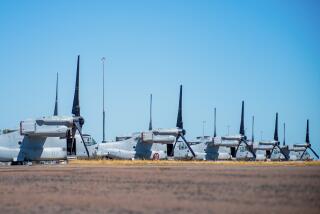Flying Aussie Doctors Seek Private Aid
- Share via
MT. ISA, Australia — The flying doctors, who travel thousands of miles a week supplying free medical treatment to the people of the outback, are looking to the corporate world to keep their service in the air.
Known in the isolated areas they serve as the “healers from the sky,” the doctors must raise more than $8 million over the next five years to help replace more than half the aircraft in their 35-plane fleet.
The planes “are the lifeblood of the outback,” said Robert Hillier, secretary-general of the Royal Flying Doctor Service of Australia.
Since the first flying doctor flight 62 years ago, the service has received state and government aid. But it cannot survive without private donations.
In many areas the flying doctors are the only source of medical help for aboriginal communities and farmers on vast, remote cattle ranches. The pilots often have to land on a stretch of earth barely cleared of undergrowth.
The annual bill for running the service, which last year tended to 143,000 patients, is $11.4 million, and every year the flying doctors struggle to balance their books.
“The major problem we have is the cost of new planes,” Hillier said. “The state and federal governments’ grants add up to about half the amount we need.”
He said suitable aircraft cost $2.7 million new or $990,000 secondhand.
The flying doctors have already accepted sponsorship from several major Australian companies, including mining giants CRA and MIM Holdings, but they say they need additional help.
The service was pioneered in May, 1928, by Presbyterian Minister John Flynn. He chose as his base the town of Cloncurry in a desolate mining and cattle area 900 miles northwest of Queensland’s capital, Brisbane.
In the late 1920s he established a radio network, powered by bicycle pedal, to keep the outback people within reach of medical aid 24-hours a day and chartered aircraft from a then-struggling airline, Qantas.
“I reckon it probably kept Qantas going,” said Hillier. Qantas is now Australia’s international flag carrier.
Cloncurry is still known as the flying doctor town, but the air medical service has been transferred to Mt. Isa, 60 miles to the west.
Heather Lawson, senior doctor at the Mt. Isa facility, and her team of pilots, nurses and radio operators, work from a base near the center of the town, overlooked by the smoking chimneys of MIM Holdings’ giant base-metals operations.
Mt. Isa, and bases in the coastal resort of Cairns and Charleville to the south, cover more than two thirds of the Queensland outback, or 290,000 square miles.
“For the people in remote parts of Australia, we are the casualty deparment, general practitioner, and their emergency transport,” said Lawson, one of two doctors at Mt. Isa.
Doctors are on call 24 hours a day, seven days a week. “They are very dedicated people,” said Hillier.
Lawson makes “house calls” three times a week, being flown hundreds of miles to hold clinics in sparsely populated areas, with makeshift huts often the only protection from the heat and flies.
Much of her work involves giving medical instruction over the airwaves and determining whether a patient’s condition is severe enough to warrant a mercy flight.
“At $4,500 an hour, we have to think seriously about taking the plane out. That can sometimes be the hardest thing,” Lawson said.
More to Read
Sign up for Essential California
The most important California stories and recommendations in your inbox every morning.
You may occasionally receive promotional content from the Los Angeles Times.













